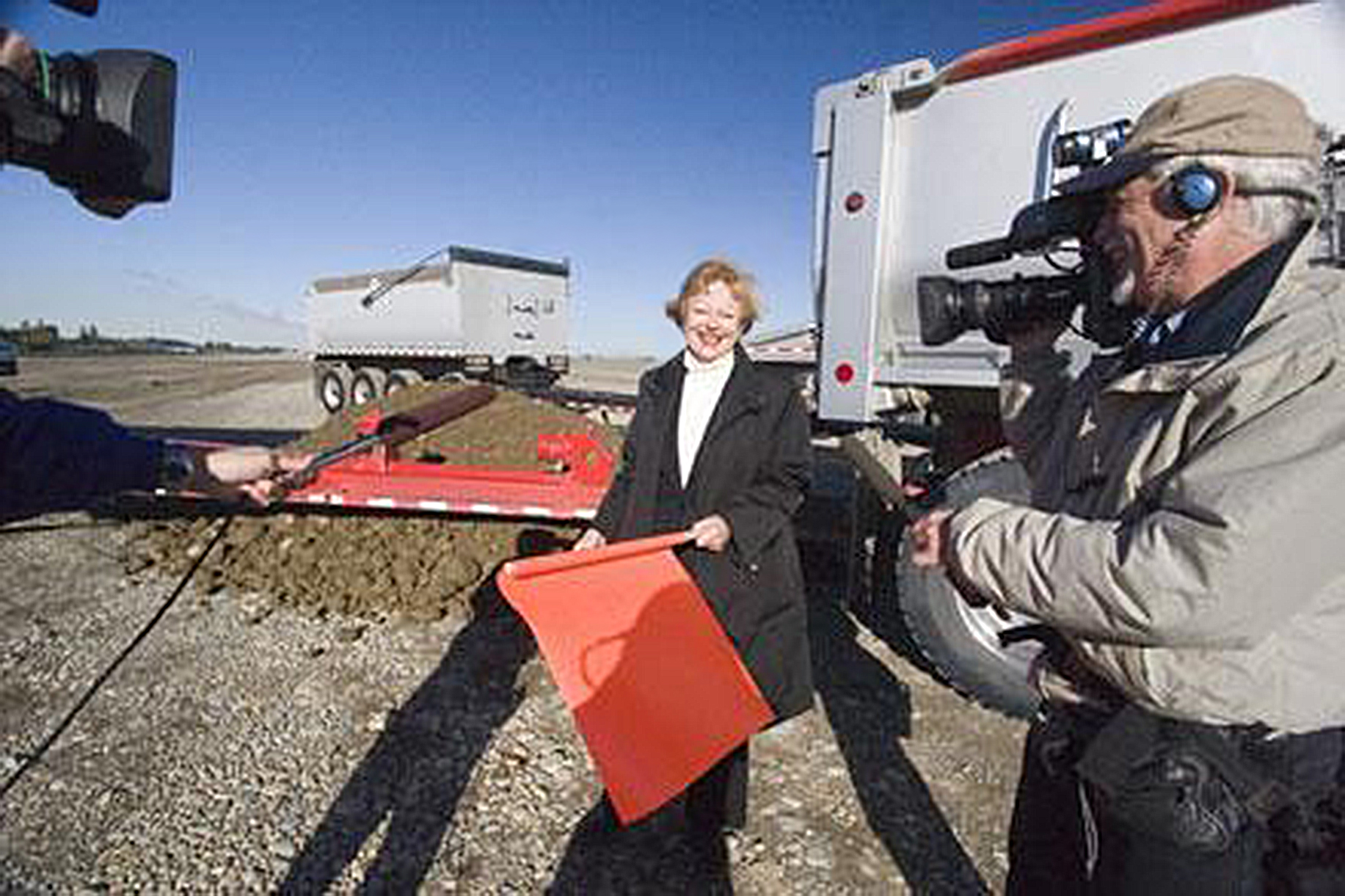
Port of Seattle Commission president Pat Davis waves a construction flag to signal the dumping of the last load of fill dirt for the third runway at Seattle International Airport. Television cameras record the moment. Photo by Amber Trillo
Tue, 11/07/2006
Port of Seattle staff celebrated on Oct. 30 the completion of the embankment for the third runway at Sea-Tac International Airport.
At a ceremony atop the embankment, Port Commission President Pat Davis arrived in a balloon-bedecked fill-dirt truck from Gary Merlino Construction.
The truck was one of 200 that has hauled about 8.5 million cubic yards of dirt to the site over the last three years.
It pulled up next to three other parked trucks representing companies that had formed TTI Contractors to handle the dirt-hauling contract.
As Davis got out of the truck, she waved an orange flag signaling the driver to empty a ceremonial small last load of dirt.
“The runway will make a wonderful addition to a major international airport,” Davis declared. “And the dirt is cleaner than dirt found on a kindergarten playground.”
Port CEO Mic Dinsmore echoed Davis’ statement, telling a reporter the runway project is among the state’s largest public works projects as well as one of the cleanest and most environmentally sound.
Davis said she is pleased that “peace has broken out” between the Port and the surrounding communities.
Neighboring cities and private citizen groups engaged in a long legal battle with the Port over environmental permits for the third runway.
The Port president noted the cities along with the city of SeaTac, which early on signed an Interlocal agreement with the Port, now meet every other month with the Port at the Highline Forum.
Forum members discuss concerns and economic development prospects.
Following the embankment ceremony and a runway tour, Port staff members gathered in a small room in the third runway construction office.
There project leader John Rothine recalled, “A lot of people worked a lot of hours including workers, inspectors and engineers. It was very much a team effort among hundreds of people.
A “Happy Birthday” banner hung on the Davis truck had surprised Rothine and a birthday cake was served at the small gathering.
Davis told the Port workers, “We’ve all been through the ringer together. We’ve gone through all the challenges, especially environmentally. The project is a benefit for the region.”
Dinsmore likened the long process of obtaining the runway permits and building the project to “giving birth to a 20-year-old child.”
Next up is the pouring of concrete for the 8,500-foot-long runway. It is set to begin this spring and end about three months later.
During that time, there will be about 70,000 truck trips, most likely during daytime hours.
The concrete will be 18 inches thick and 150 feet wide, according to Port spokesman Bob Parker.
About 130,000 cubic yards of concrete pavement and 35,000 tons of asphalt pavement will be used for the runway and eight connecting taxiways.
The first airplane landing is scheduled for late 2008.
About 17 million cubic yards of fill material were used in the embankment with 4.5 million cubic yards delivered in 2002-2003 and another 8.5 million cubic yards delivered in the past three years.
Three million cubic yards were excavated on the site.
During 2004-2005, trucks made more than 394,000 trips on Highline freeways, according to the Port.
Trucks hauled the dirt up to 20 hours a day, six days a week. On a peak day, about 1.800 deliveries were made with about 58,000 tons delivered.
The embankment is 13 stories tall at its highest point. It required three mechanically stabilized earth walls to reduce impacts on nearby Miller Creek and wetlands.
It is one of North America’s tallest mechanically stabilized earthen retaining walls. Sensors are attached to detect movement in the walls.